Opinion
The Gray Market: Why the Sackler Philanthropy ‘Halt’ Could Mean Even Bigger Changes for Museum Funding (and Other Insights)
How the “Overton Window” theory in politics applies to recent trends in arts philanthropy.
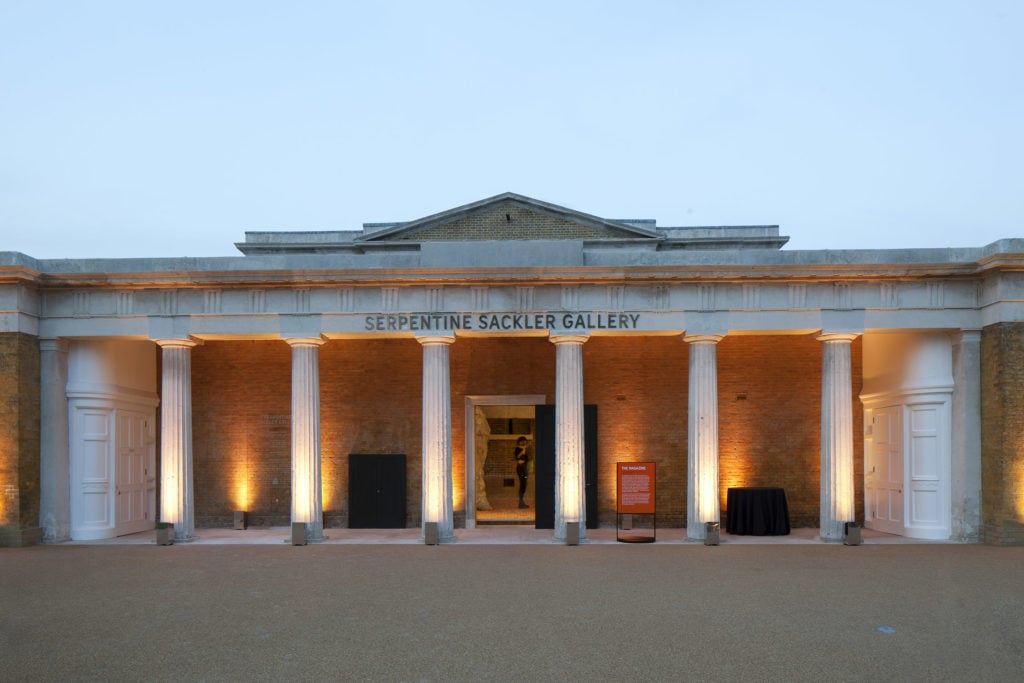
How the “Overton Window” theory in politics applies to recent trends in arts philanthropy.

Tim Schneider

Every Monday morning, artnet News brings you The Gray Market. The column decodes important stories from the previous week—and offers unparalleled insight into the inner workings of the art industry in the process.
This week, surveying a newly altered landscape of museum fundraising…
On Monday, a bombshell landed in the world of arts philanthropy, as the Sackler Trust and the Dr. Mortimer and Theresa Sackler Foundation announced in separate statements (with select matching verbiage) that they would “temporarily pause all new philanthropic giving, while still honoring existing commitments.”
Although the two organizations operate independently, both are endowed by the fortune of Mortimer Sackler, who, along with his younger brother Raymond, led Purdue Pharma while it pioneered, marketed, and sold OxyContin, one of the drugs at the heart of the American opioid crisis. (Theresa Sackler is Mortimer’s third wife and widow. A third Sackler brother, Arthur, died before OxyContin’s development, siloing his heirs from proceeds from the drug and giving them the relative moral high ground against other branches of the family.)
How big a deal is this? The Sackler Trust alone has awarded £60 million ($79 million) to arts, medical-research, and educational organizations since 2010, including sizable gifts to the UK’s National Gallery and the Victoria and Albert Museum, as well as the Guggenheim and the Met in New York. Any further philanthropy will now be put on ice until, as Theresa Sackler put it in her statement, “We can be confident that it will not be a distraction for institutions that are applying for grants.”
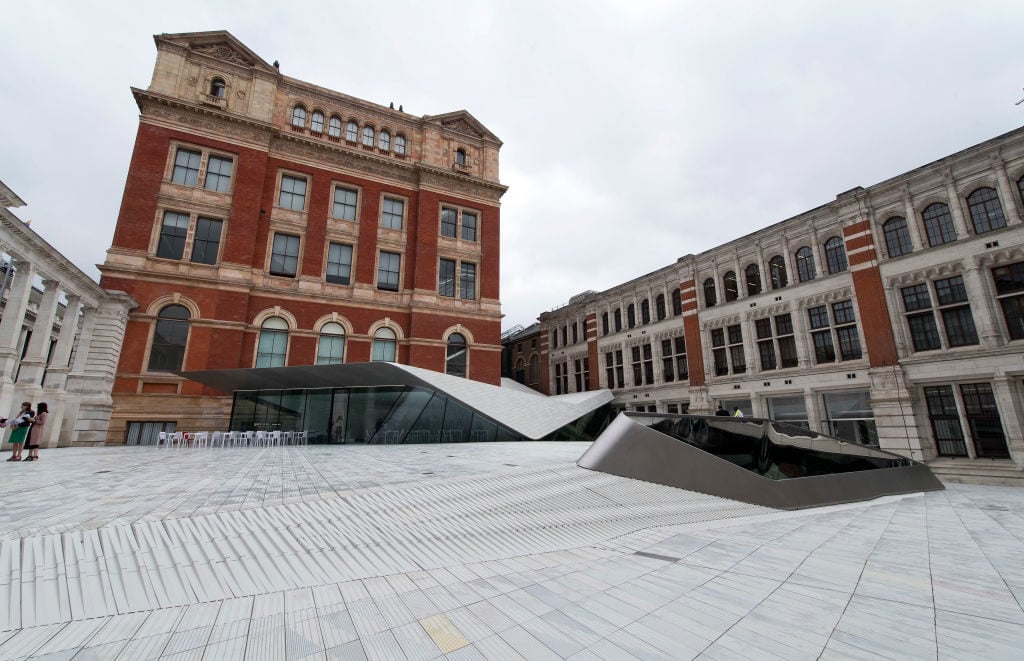
The Sackler Courtyard at the Victoria and Albert museum in London. Photo: Justin Tallis/AFP/Getty Images.
As for the distraction element: A day after the Sackler Trust and Dr. Mortimer and Theresa Sackler Foundation announced they were pressing pause on new giving, Purdue Pharma reached a $270 million settlement with the attorney general of Oklahoma over a lawsuit alleging Purdue’s culpability in the state’s multibillion-dollar struggle with opioid addiction. Yet the resolution of that case still leaves Purdue Pharma to contend with 35 state cases and more than 1,600 others consolidated at the federal level, all regarding OxyContin, according to the New York Times. On Friday, New York attorney general Letitia James announced that the state was adding Purdue Pharma and eight members of the Sackler family to one of its ongoing lawsuits, accusing the family of fraud and illegal profiteering.
Purdue Pharma and the heirs of Mortimer and Raymond Sackler deny all wrongdoing. And the company is not alone in being dragged into the courts over opioids. “Nearly two dozen other defendants” in the pharmaceutical industry have been named as defendants in litigation related to the much-abused class of drugs, according to attorneys in the consolidated federal case.
The Sackler Trust and the Sackler Foundation’s joint halt in giving comes after mounting public pressure from direct-action groups led by Nan Goldin’s Prescription Addiction Intervention Now (PAIN). That pressure seems to have burst a few notable pipes recently, as recapped by my colleague Julia Halperin:
The trust’s decision to pause its activities follows a series of major announcements last week from institutions that stated they would no longer accept money from the Sackler family. The National Portrait Gallery announced it had reached a “mutual” agreement with the Sackler Trust to drop a planned £1 million ($1.3 million) pledge for its refurbishment. Several days later, the Tate announced it would no longer accept funds from the Sacklers.
For arts-funding purists, these are colossally encouraging developments. It seems clear that philanthropy’s commercial source is now getting the type of hard look that many think it has deserved for much longer. But to understand exactly how meaningful this situation may be, we should view this new chapter in a broader context.
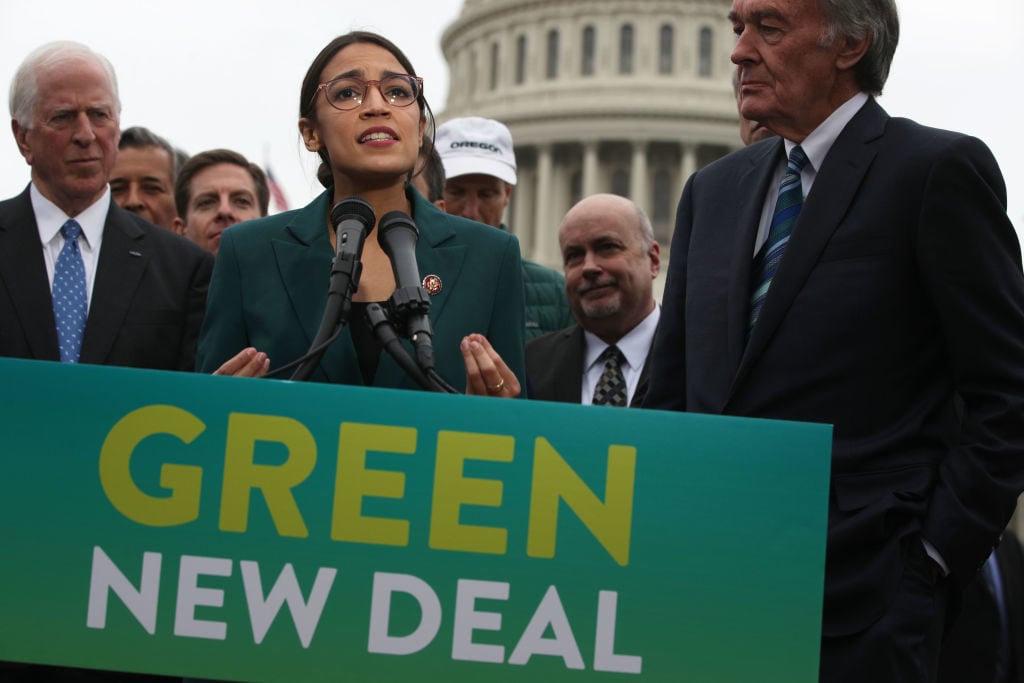
U.S. Rep. Alexandria Ocasio-Cortez speaks about the Green New Deal during a news conference outside the U.S. Capitol in February 2019. Photo by Alex Wong/Getty Images.
Media-theory geeks like me are already familiar with the concept of the Overton Window. For those of you who lead healthier and more well-rounded lives, though, the Overton Window—named for Joseph Overton, president of the Mackinac Center for Public Policy—describes the range of outcomes that are politically acceptable at a given moment in time. The key point lies in the definition of “politically acceptable.” Basically: How far can a candidate go on a particular issue before they risk losing an election over their stance?
In other words, the Overton Window isn’t framed by a candidate’s personal preferences. It is framed by the public’s sense of what is tolerable, if not desirable.
This is one reason that the discourse about any issue amounts to more than just talk. It’s really hard to do something that you can’t even publicly discuss lest the average voter label you something between an unelectable extremist and, as my grandpa termed it, a straight-up Looney Toon. So if you want to take more radical action, you first have to make the argument for it seem less radical. You have to move the Overton Window.
How do you do that? Usually, by managing to find one special person or event that resonates despite occupying what is, at the time, an outlier position, and then building around them.
For better and worse, we live in an era overflowing with examples on both sides of the political spectrum. If you want the United States to adopt full democratic socialism, you first need, say, a congressional representative like Alexandria Ocasio-Cortez to enthrall traditional media and continuously go viral on social media for gleefully dunking on the GOP in service of things like universal healthcare and the Green New Deal. On the other side, if you want to build a wall along America’s southern border and resurrect Jim Crow, you first need, say, an intellectual troglodyte like congressional representative Steve King to sustain a nine-term career spewing white-supremacist bile that brings no major political consequences.
But the Overton Window doesn’t just apply to politics. It can apply to any niche where public opinion determines outcomes.
For example, you don’t get decent-to-good Mexican restaurants in middle America without Taco Bell first establishing itself as a money-making fast-food chain nationwide. The iPhone doesn’t become one of the best-selling devices of all time if someone doesn’t first manage to create a market for mobile phones bulky enough to ram through castle doors. If you’re trying to figure out how a dude named Lil Nas X had a hit on Billboard’s Hot Country Songs charts until it was later removed for effectively being too hip hop, you probably have to work through early ‘00s window-movers like Bubba Sparxx’s Deliverance and that collab between Nelly and Tim McGraw.
And this (weirdly) leads us back to the ethical tsunami crashing onto the shores of arts philanthropy.
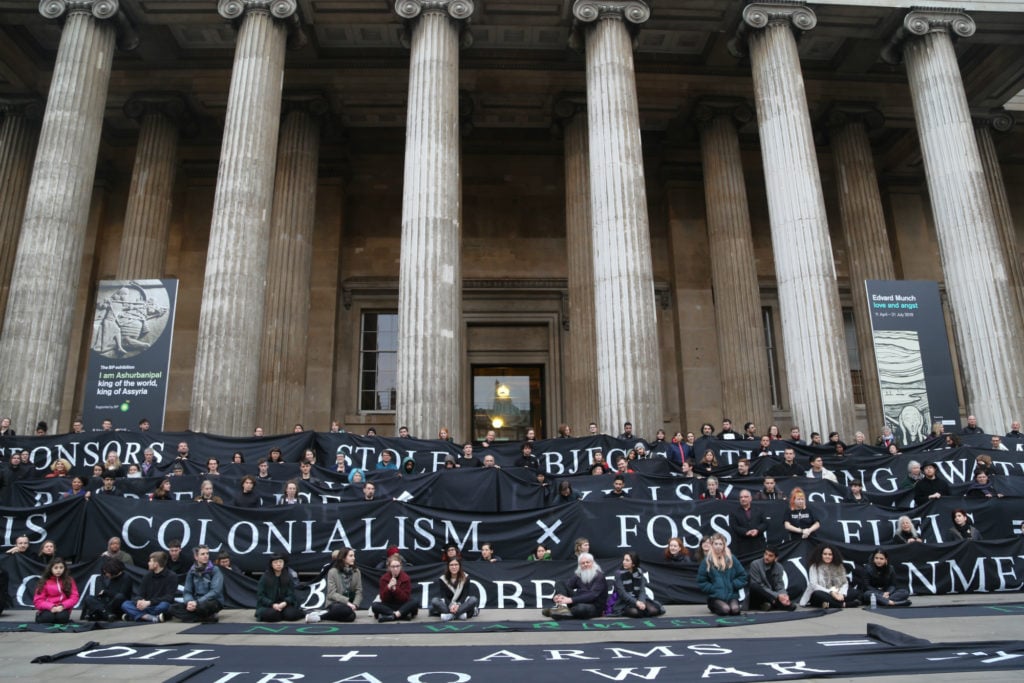
Climate change activists protest at the British Museum. Photo by Diana More, courtesy of BP or not BP?
Part of the reason I see the Sackler Trust and Sackler Foundation’s funding freeze as a shift of the Overton Window is because of what has preceded it in the past 15 months. Crucially, that stretch has delivered numerous non-Sackler milestones in the realm of ethical arts philanthropy—handholds that have helped Goldin, PAIN, and other demonstrators to pry the window open further than it’s opened in recent memory.
Last January, Shell and London’s National Gallery decided not to renew a corporate sponsorship deal that had run for the previous 12 years. (It happened so quietly that no one in the media found out until 10 months later.) That relationship had been the target of sustained demonstrations for most of its life, highlighted by Greenpeace unfurling a massive banner on the gallery’s roof that read, “It’s Not an Oil Painting” back in 2012. But from the outside, it looks as though the protests eventually had their intended effect.
Not that Shell or the gallery have ever said as much. Each seemed to take credit for sunsetting the deal for entirely different reasons. Shell told The Guardian it wanted to channel more money into STEM education, and the National Gallery pointed Frieze to its “ethical fundraising policy,” which was apparently interpreted very differently for the previous 12 years—when, incidentally, there was far less impassioned rhetoric about the need for institutions to divest from problematic donors. Just goes to show you: Whether we’re talking about corporations, nonprofits, or people, never underestimate the universal desire to control a breakup narrative.
Shell’s National Gallery patronage wasn’t the only scalp collected by activists for ethical fundraising in 2018. In August, the Van Gogh Museum and the Mauritshuis each wound down their own multi-year relationships with the oil giant. Those results were determined by “mutual decision,” if you choose to believe a statement from Shell Nederland. However, demonstrators had intensified their actions at both museums in the preceding months, and it’s at least fair to wonder whether institutional leadership knew before the rest of us that the National Gallery and Shell had set a nascent precedent with their own annulment.
The activity wasn’t all about oil, either. Last fall, the Met and the Brooklyn Museum both rejected funds offered by Saudi Arabia for the wide-ranging Arab Art & Education Initiative. Those decisions came in the aftermath of the suspected murder of Saudi expatriate-journalist Jamal Khashogghi, which US intelligence officials and congressmen would later conclude originated from a direct order by crown prince Mohammed bin Salman.
Through the Overton Window, it’s not hard to daisy-chain these events into a narrative about advancing progress on ethical fundraising at arts institutions—one that the freeze on new Sackler funding extends even further than ever.
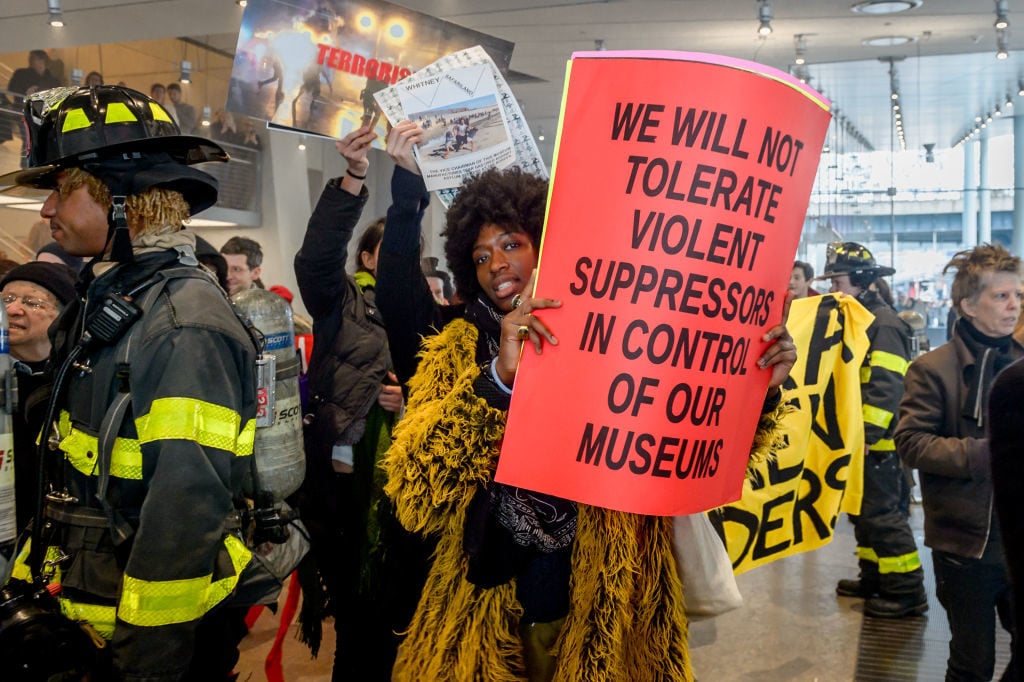
Activists protested last year and again over the weekend at the continued presence of Whitney Museum’s controversial trustee Warren B. Kanders. Photo by Erik McGregor/Pacific Press/LightRocket via Getty Images.
How does this narrative progress? Despite their protestations to the contrary, the National Gallery, Van Gogh Museum, and Mauritshuis all seem to have caved to public pressure over Shell’s patronage, but only after accepting funding for six years or more. By contrast, the Met and the Brooklyn Museum doubled back to decline Saudi funding within only a few weeks of the Khashoggi debacle (although a legitimate argument exists that Saudi human-rights violations should have complicated, if not severed, those relationships decades earlier).
The Sackler bombshell opens the Overton Window even wider. It isn’t just that the National Portrait Gallery and Tate announced refusals of the family’s money in short order (and, to a lesser extent, the Guggenheim, which said in a statement that the museum has not been offered any Sackler funding since 2015 and currently has “no plans” to receive more). It’s that those rejections at least seem to have contributed to the Sackler Trust and the Sackler Foundation deciding to stop trying to give money to anyone else, too. If you want ethically pure philanthropy to be the standard, that’s a real step forward.
There are caveats to this narrative, of course. As Halperin pointed out, Mortimer and Raymond Sackler’s fortunes continue to fuel other philanthropic entities that have not announced any moratorium on donations, including the Mortimer and Theresa Sackler Foundation and the Raymond and Beverly Sackler Foundation. It’s also fair to wonder whether the Sackler Trust and the Foundation would have hit pause on their giving if Purdue Pharma (and, at least in Massachusetts and New York, select Sackler family members) weren’t engulfed in a gauntlet of lawsuits.
Still, these outside factors don’t negate the effects of actions by arts activists. However many hands are pushing, the Overton Window for ethical philanthropy seems to be moving farther and faster than I’ve seen in my lifetime.
That should hearten groups like BP or Not to BP? on its targeting of the British Museum over patronage from (you guessed it) BP, and Decolonize This Place on its targeting of the Whitney over trustee Warren B. Kanders. And it should also cue even traditionally skeptical observers like me to the possibility that maybe, just maybe, even bigger changes than we imagined might fit through the opening soon.
That’s all for this week. ‘Til next time, remember: Things change very slowly, then all at once.